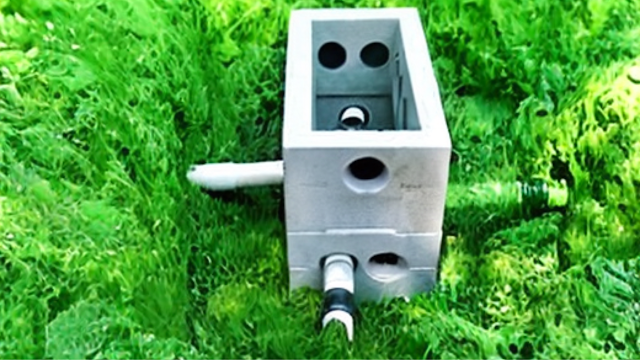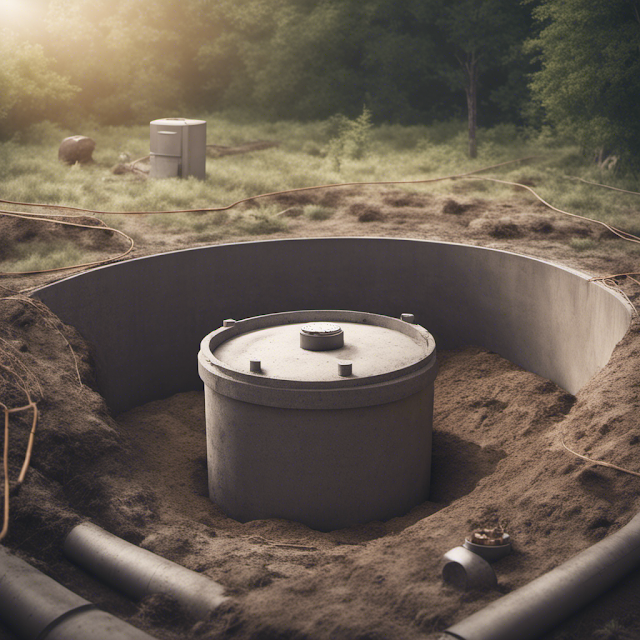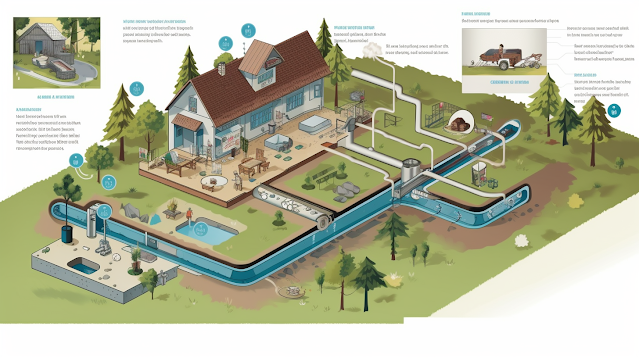Comprehensive Guide To Septic System Design: Sizing, Layout, And Installation Tips
 |
| Septic System design |
Introduction to Septic System Design
Do you want to avoid a septic system
disaster? Then this comprehensive guide is for you! With the right knowledge
and techniques, designing and installing a septic system can be a smooth
process. But one wrong move could lead to costly repairs, environmental damage,
or even health hazards. That's why it's crucial to get it right from the start.
In this guide, we will walk you through
every step of septic system design, from assessing your property to troubleshooting
common issues. You'll learn how to determine the ideal size of your septic tank
based on factors such as household size, water usage, and soil type.
We'll also cover various types of septic
systems and their pros and cons, so you can choose the best fit for your needs.
Plus, we'll share tips on selecting high-quality components that will ensure
your system functions properly for years to come.
So buckle up and get ready to become a
septic system expert!
Key Takeaways
•
Proper design and installation
of septic systems is crucial to avoid repairs, environmental damage, and health
hazards.
•
Factors such as property size,
occupants, and soil type need to be considered when designing a septic system.
•
Regular maintenance, pumping,and inspection are necessary to ensure long-term optimal performance.
•
Troubleshooting common issues
such as slow sewage flow rate, unpleasant odors, and backed-up drains can
prevent major setbacks. Consulting with professionals is recommended for
complex issues.
Understanding the Basics of Septic Systems
 |
| Septic System Design Diagram |
You're probably wondering, just like a curious child peeking under the hood of a car, how exactly does a septic system work?
A septic system is an underground
wastewater management structure that processes household sewage. It consists of
several components, including the septic tank, soil absorption system or drainfield, and connecting pipes.
The design parameters for septic systems
depend on factors such as property size, number of bedrooms or occupants, and
soil type. When it comes to septic tank size for residential properties, the
general rule is to have a minimum capacity of 1,000 gallons for up to three
bedrooms. For larger households or commercial properties with higher wastewater
flows, tanks can range from 1,500 to 2,500 gallons or more.
There are different types of septic
systems available based on specific requirements and site conditions. Some
examples include aerobic treatment units (ATUs), mound systems, sand filters
and peat filters.
Septic system installation involves
several steps that must be carried out by certified professionals in accordance
with local regulations and environmental reports. First off is assessing your
property's suitability for a new or replacement septic system by checking soil
conditions and land use restrictions. Then comes designing the system layout
that meets code requirements and allows easy access during maintenance
activities.
Proper installation not only ensures efficient treatment but also minimizes damage risks from leaks or overflows. In conclusion, understanding the basics of septic system design is essential when planning a new build or upgrading an existing one.
By knowing the rules ( also you need to comply with regulations)governing septic tank sizing and installation procedures along with various
types of systems available based on specific needs, you will make sure you
choose the best solution for your property's wastewater management needs before
assessing your options through property evaluation methods discussed in our
next section about 'assessing your property for septic system design.'
Assessing Your Property for Septic System Design
When evaluating your land, it's important to consider factors like soil type and topography to determine the best placement for your septic setup. To properly assess your property, keep the following in mind:
•
Soil type: The composition of
the soil will affect how well it can absorb and filter wastewater. A
percolation test can determine whether your soil is suitable for a new septic
tank.
•
Topography: The slope and
elevation of your land can impact the flow of wastewater from your home to the
septic system. Avoid placing the tank or drainfield in low-lying areas or near
bodies of water.
•
Tank capacity: Calculate the
average water usage in your household to determine what size septic tank you
need. This will depend on factors such as number of bedrooms and bathrooms,
frequency of laundry loads, and use of dishwashers.
•
Septic regulations: Check with
local health departments for any specific regulations that may apply to septic
system design in your area.
Once you have assessed these factors,
you can begin planning the layout and design of your septic system. This will
involve determining appropriate dimensions for both the tank itself and its accompanying
drainfield.
Septic system calculations should include
consideration for how much wastewater needs to be treated based on anticipated
household usage.
Drainfield design is also critical; this
area must be large enough to allow proper drainage without causing
contamination of surrounding soils or groundwater. Leach field placement should
take into account proximity to trees or other vegetation that could interfere
with drainage.
To help visualize all aspects of
designing a new septic system, consider creating detailed diagrams that
illustrate each component. These diagrams should include measurements for every
element involved, from tank capacity and drainfield length to pipe diameter and
depth.
In order to ensure compliance with local
regulations regarding septic constituents, it's essential that you work closely
with professionals who are experienced in this field. Certified installers can
help guide you through each step of the process, ensuring that your new septic
tank and its accompanying components are designed and installed according to
all applicable laws and regulations.
When choosing the right septic system
size for your property, it's important to consider both current needs as well
as any potential future growth. The next section will explore strategies for
determining appropriate tank capacity based on household use patterns.
Choosing the Right Septic System Size
To ensure that your septic system can handle both your current and future needs, it's important to consider factors such as household water usage patterns when choosing the appropriate tank size. The size of your sewage tank will determine how much waste storage capacity you have, which is critical for ensuring the proper functioning of your septic system.
The guidelines and design specifications
for determining the appropriate tank volume vary depending on whether you are
using a gravity or pump system. Tank size calculation involves estimating your
daily water usage and then multiplying this amount by an estimated retention
time to determine the size of your sewage tank. This calculation is typically
done by a qualified designer who will use septic system drawings and other
relevant information to determine the ideal tank size for your property.
In addition to these requirements, local
regulations may also specify minimum sizing standards that must be followed in
order to obtain necessary permits for installation. It's important not to
underestimate the importance of choosing an appropriately sized sewage tank. If
you choose a tank that is too small, you risk overloading the system with
excessive amounts of waste, leading to potential health hazards and
environmental damage. On the other hand, choosing a larger than necessary tank
can result in unnecessary expenses during installation and maintenance.
Determining the ideal septic system
layout requires careful consideration of several different factors beyond just
selecting an appropriate sewage tank size. You'll need to evaluate soil
permeability, site topography, setbacks from wells or streams, and other
site-specific conditions before finalizing your design plans.
Determining the Ideal System Layout
Determining the ideal system layout involves careful consideration of factors such as soil permeability, site topography, and setbacks from wells or streams, which can greatly impact the overall effectiveness of your septic system.
To begin with, you should consult design
standards and regulations set by your local health department. This will help
you understand what types of sewage systems are allowed in your area and how
much space they require. Once you have a basic understanding of these
requirements, you can start exploring different septic tank designs and sewage
system types to see which ones would work best for your property.
As you evaluate various septic
arrangements, it's important to keep in mind that there are many variations in
septic systems. Some systems use gravity to transport wastewater from house to
drainfield, while others rely on pumps or other mechanical components.
Additionally, different types of drainfields may be required based on soil
qualities and other factors.
Sewage system sketches, septic system
blueprints, and illustrations can all help you visualize the options available
to you. One crucial element in determining the ideal layout is calculating the
necessary drainfield dimensions for your household size and anticipated water
usage patterns.
This calculation takes into account
several factors such as soil percolation rate, total daily wastewater volume
generated by household members and visitors alike. You also need to factor in
potential future growth plans that may lead to increased wastewater production.
Overall, selecting the best septic system
components involves not only choosing appropriate equipment but also properly
designing its placement on your property. By carefully evaluating variables
like soil type/quality or distance from wells/streams against regulatory
requirements/guidelines; using detailed calculations when planning layouts;
considering different arrangements (gravity-based systems vs pump-based)
depending upon specific needs – homeowners can make informed decisions about
their home's wastewater treatment process without any worry!
Selecting the Best Septic System Components
You'll want to get the perfect septic system setup for your property, and that means selecting components that will work best for your specific needs. There are several elements you need to consider when choosing the right parts for your sewage system. These include the type of tank, effluent pump system, pressure distribution septic, and other necessary septic parts.
Firstly, let's talk about replacement
septic tanks. If you already have a septic tank installed on your property but
it is old or damaged beyond repair, then you may need to purchase a new one.
When choosing a replacement tank, make sure to select one that meets the
minimum size requirements for your household's wastewater output.
Effluent pump systems are another
important component of any modern septic setup. This type of pump is used to
move wastewater from the treatment tank into a drain field or other disposal
area. You can choose between submersible pumps or external pumps depending on
what works best for your specific situation.
Lastly, pressure distribution septic
systems are becoming increasingly popular due to their efficiency and
effectiveness in treating wastewater. This type of system uses a network of
pipes that distribute treated water evenly across the soil in a drain field or
other designated area. With all these sewage system elements in mind, it's
important to consult with professionals who specialize in wastewater tank
installation and pump septic systems before making any final decisions.
With all this information at hand
regarding selecting suitable components for your septic system setup, it's time
to focus on installing your new system correctly. In the next section we will
provide you with an informative step-by-step guide along with key tips and
tricks so as not to encounter future issues down the line!
Installing Your Septic System: Step-by-Step Guide
.jpg) |
| installing a septic tank |
Get ready to transform your property with a flawless septic system installation - it's time to roll up your sleeves and dive into the process! Before beginning, make sure you have all the necessary wastewater system parts. These include a septic tank, leach field components, pipes, and fittings. The size of each part should be in accordance with the sewage flow rate and leach field calculations.
Different septic designs exist, but
gravity-fed septic systems are commonly used due to their simplicity and low
maintenance requirements. Installing a septic tank involves digging a hole that
is deep enough for its size and positioning it correctly. It should be at least
10 feet away from any building or water source to avoid contamination. After
installing the tank, connect it to the leach field components using pipes.
A pumping sewage system might be required
if the site's slope or groundwater level does not allow for gravity-fed
drainage. In such cases, you'll need an additional pump chamber that will
collect waste from your house before pumping it uphill to the drainfield area.
Proper positioning of this chamber is crucial as it affects how efficiently
wastewater flows through your system.
To ensure optimal performance of your new
sewage system setup, follow manufacturer instructions closely during
installation. Additionally, make sure to carry out regular cleaning and
maintenance checks on different parts of your septic system over time. This
includes regular pumping out of solid waste from your tank every one to three
years depending on household usage levels.
As you finalize installation of your new
sewage system setup, remember that proper maintenance is key in ensuring
long-term optimal performance of these systems. Regular cleaning checks,
combined with proper use, can keep your wastewater treatment plant running
smoothly for years without problems cropping up unexpectedly - which would lead
to expensive repairs down the line!
Maintaining Your Septic System for Optimal Performance
Ensure your septic system stays in top shape by giving it regular TLC - just like you would with any other important investment! Proper maintenance of your sewage system setup is crucial to avoid costly repairs and prevent hazardous waste from contaminating the environment.
One of the most important components of a
new sewage system is its wastewater system parts, which include the septic
tank, distribution box, and leach field. These parts must be installed
correctly to ensure that they function properly.
Regularly pumping your sewage system is
also essential for maintaining optimal performance. The frequency of this
process depends on factors such as the size of your tank and sewage flow rate -
which can be determined during initial leach field calculations. A professional
should handle this task because they have the necessary equipment and expertise
to safely dispose of the waste.
Different septic designs suit different
households depending on their needs and location. Various septic systems
include gravity-fed systems, pressure distribution systems, mound systems, sand
filters, and aerobic treatment units. Installing a septic tank that fits your
household's size is critical because an undersized tank may cause frequent
backups while an oversized one can lead to unnecessary pumping costs.
Maintaining your septic system involves
more than just pumping it out every few years; it requires diligent monitoring
for signs of trouble like slow drainage or unpleasant odors in the house.
Keeping thorough records of all maintenance activities will help identify
potential issues early on so they can be addressed promptly before causing
significant damage or requiring expensive repairs.
As you've learned how vital proper
maintenance is for keeping your septic system functioning optimally, let's move
onto troubleshooting common septic system issues!
Troubleshooting Common Septic System Issues
Experiencing problems with your septic system can be a frustrating and stressful situation, but don't worry - troubleshooting common issues is easier than you might think! Here are three common septic system problems and how to fix them:
1.
Slow sewage flow rate: If you
notice that water is slow to drain from sinks or toilets in your home, it could
be a sign of a slow sewage flow rate. This issue can be caused by clogs in the
wastewater system parts or an overflowing tank. To fix this problem, try
pumping the sewage system to remove any buildup that may be causing the
blockage.
2.
Leach field failure: A leach
field is an essential component of any new sewage system setup as it allows for
proper drainage of waste into the surrounding soil. However, if a leach field
becomes clogged or damaged, it can cause wastewater to back up into your home
or yard. Calculating the correct size and placement of a leach field during
installation is crucial to preventing future issues.
3.
Tank overflow: An overflowing
septic tank can lead to unpleasant smells and potential health hazards on your
property. The most common cause of tank overflow is neglecting routine
maintenance such as pumping out solids regularly or installing too small of a
tank for household usage. Installing a larger septic tank or increasing pumping
frequency can help prevent this issue from occurring again.
Remember that different septic designs
require different solutions to their specific problems, so it's important to
consult with professionals when dealing with complex issues beyond basic
troubleshooting tips. Properly installing a septic tank and maintaining its functionality
will ensure optimal performance for years to come without experiencing any
major setbacks related to troubleshooting common septic system issues.
Frequently Asked Questions
How often should a septic system be pumped?
To prevent septic system failure and
costly repairs, it's recommended to have your tank pumped every 3-5 years. A
professional will remove accumulated solids, ensuring proper function of the
system.
Can a septic system be installed on a sloped property?
Yes, a septic system can be installed
on a sloped property. It requires careful planning to ensure proper drainage
and avoid soil erosion. A qualified septic system designer can assess the site
and design an appropriate system for your property's slope.
Are there any specific regulations or permits required for
a septic system installation?
You may need specific permits and
regulations for a septic system installation, depending on your location. These
can include soil testing, engineering plans, and approval from local health
departments or building authorities.
What kind of maintenance should be done on a septic system
and how often?
To maintain your septic system, have
it inspected every 1-3 years by a professional. Pump the tank every 3-5 years
depending on household size and usage. Avoid flushing non-biodegradable items
or chemicals down the drain.
Can a septic system be installed in an area with high
groundwater levels?
Yes, a septic system can be installed
in an area with high groundwater levels. However, it requires careful
consideration of the type of system and its location to prevent contamination.
Consult a professional for site-specific recommendations.
.png)



.png)






Comments
Post a Comment